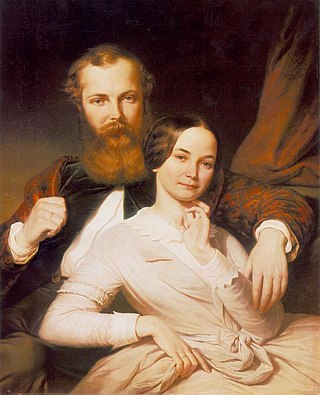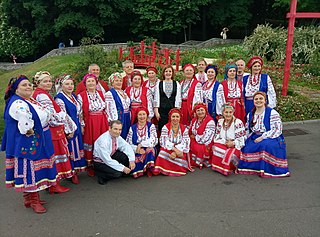The Mazurka is a Polish musical form based on stylised folk dances in triple meter, usually at a lively tempo, with character defined mostly by the prominent mazur's "strong accents unsystematically placed on the second or third beat". The Mazurka, alongside the polka dance, became popular at the ballrooms and salons of Europe in the 19th century, particularly through the notable works by Frédéric Chopin. The mazurka and mazurek are often confused in Western literature as the same musical form.
The music of Greece is as diverse and celebrated as its history. Greek music separates into two parts: Greek traditional music and Byzantine music. These compositions have existed for millennia: they originated in the Byzantine period and Greek antiquity; there is a continuous development which appears in the language, the rhythm, the structure and the melody. Music is a significant aspect of Hellenic culture, both within Greece and in the diaspora.
Hungary has made many contributions to the fields of folk, popular and classical music. Hungarian folk music is a prominent part of the national identity and continues to play a major part in Hungarian music. The Busójárás carnival in Mohács is a major folk music event in Hungary, formerly featuring the long-established and well-regarded Bogyiszló orchestra. Instruments traditionally used in Hungarian folk music include the citera, cimbalom, cobza, doromb, duda, kanászkürt, tárogató, tambura, tekero and ütőgardon. Traditional Hungarian music has been found to bear resemblances to the musical traditions of neighbouring Balkan countries and Central Asia.
Ukrainian music covers diverse and multiple component elements of the music that is found in the Western and Eastern musical civilization. It also has a very strong indigenous Slavic and Christian uniqueness whose elements were used among the areas that surround modern Ukraine.
Music of Serbia represents the musical heritage of Serbia, both historical and modern. It has a variety of traditional music styles, which are part of the wider Balkan musical tradition, with its own distinctive sound and characteristics.

Hungarian culture is characterized by its distinctive cuisine, folk traditions, poetry, theatre, religious customs, music and traditional embroidered garments. Hungarian folklore traditions include tales, music, dance, decorated pottery, carvings and embroidery. Historically, Hungarian music has largely consisted of folk music and classical and baroque pieces. Hungary shares cultural similarities with its neighbouring countries as well as with Turkic nations in Asia, the latter stemming from a history of interaction between Hungarians and Turkic peoples. Noted Hungarian authors include Sándor Márai, Imre Kertész, Péter Esterházy, Magda Szabó and János Kodolányi. Imre Kertész is particularly noteworthy for having won the Nobel Prize in Literature in 2002.

Lajos Bárdos was a composer, conductor, music theorist, and professor of music at the Franz Liszt Academy of Music, in Budapest, Hungary, where he had previously studied under Albert Siklós and Zoltán Kodály. His younger brother, György Deák-Bárdos, was also a composer.
Laïko or laïkó is a Greek music genre composed in Greek language in accordance with the tradition of the Greek people. Also called "folk song" or "urban folk music" in its plural form, it is a Greek music genre which has taken many forms over the years. Laïkó followed after the commercialization of Rebetiko music. It is strongly dominated by Greek folk music and it is used to describe Greek popular music as a whole. When used in context, it refers mostly to the form it took in the period from the 1950s to the 1980s.

Little is known about Hungarian music prior to the 11th century, when the first Kings of Hungary were Christianized and Gregorian chant was introduced. During this period a bishop from Venice wrote the first surviving remark about Hungarian folk song when he commented on the peculiar singing style of a maid. Church schools in Hungary taught Western Christian chanting, especially in places like Esztergom, Nyitra, Nagyvárad, Pannonhalma, Veszprém, Vác and Csanád; and later schools began focusing on singing, spreading Latin hymns across the country.
Hungarian folk music includes a broad array of Central European styles, including the recruitment dance verbunkos, the csárdás and nóta. It is characterised by complex melodic patterns, rhythmic diversity, ornamentalisation and the use of a distinctive blend of traditional instruments. Instruments traditionally used in Hungarian folk music include the citera, cimbalom, cobza, doromb, duda, kanászkürt, mandolin, tárogató, tambourine, tambura, tekero and ütőgardon.

Mihály Mosonyi was a Hungarian composer. Born Michael Brand, he changed his name to Mosonyi in honor of the district of Moson, with Mihály being the Hungarian equivalent of "Michael". Like many of his peers, he was interested in creating a Hungarian musical style.

István, a király is a Hungarian rock opera with music by Levente Szörényi, lyrics by János Bródy and book by Bródy and Miklós Boldizsár, based on the latter's play, Ezredforduló.

Ukrainian folk music includes a number of varieties of traditional, folkloric, folk-inspired popular music, and folk-inspired European classical music traditions.

Besh o droM is a Balkan music group. Their music blends folk and contemporary instruments (including the cymbalom and the EWI, in styles ranging from punk-rock to world music. They acknowledge particular influences from Transylvanian, Jewish, Turkish, Afghan, Egyptian, Lebanese, Armenian, Bulgarian, Romanian, Macedonian and Greek musical traditions.

Kálmán Balogh is a Hungarian cimbalom player and leader of Kálmán Balogh's Gypsy Cimbalom Band.
An Imaginary Report on an American Rock Festival is a Hungarian musical by composer Gábor Presser, lyricist Anna Adamis and book writer Sándor Pós based on the short novel of the same name by Tibor Déry. The musical premiered in 1973, and being the first successful Hungarian rock musical opened the way for popular music to Hungarian theatres and literature. It is set in a U.S. rock festival and tells a story of a married Hungarian immigrant couple.
Hungarian pop is the pop music scene of Hungary. It is often associated with Rezső Seress's song "Gloomy Sunday" which was covered by numerous artists. The most notable artists include Zsuzsa Koncz, Kati Kovács, János Bródy, Zorán, Péter Máté and famous bands like Illés, Quimby, Republic,Locomotiv GT, Omega, Neoton Família. Among the new talents are Azariah, Krúbi, and Dzsúdló.
Magyar népdalok énekhangra és zongorára is a collection of Hungarian folk song arrangements by Béla Bartók. Bartók's Hungarian Folksongs are now much better known outside Hungary in arrangements for violin and piano, or—without voice—for piano alone. One of the most famous songs "Elindultam szép hazámból" came to be applied to Bartók himself as he assumed the role of an exile.
"Lakodalmas", commonly translated into English as "Wedding Dance", is an early vocal composition by Hungarian composer György Ligeti. It was completed in 1950, before he finished his musical studies.

Károly Horváth was a Romanian-born composer and musician. He spent most of his professional life in Hungarian theatre.










